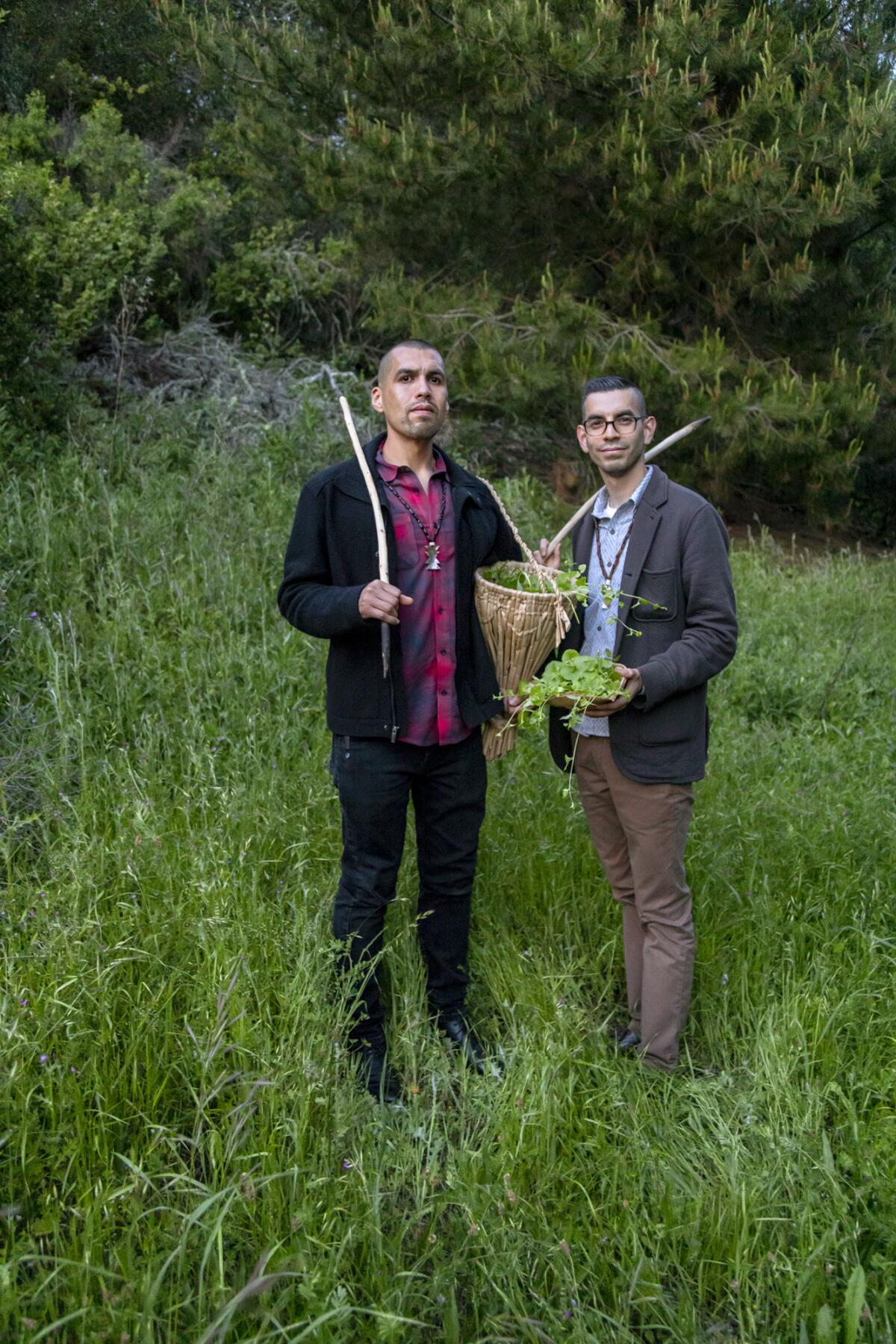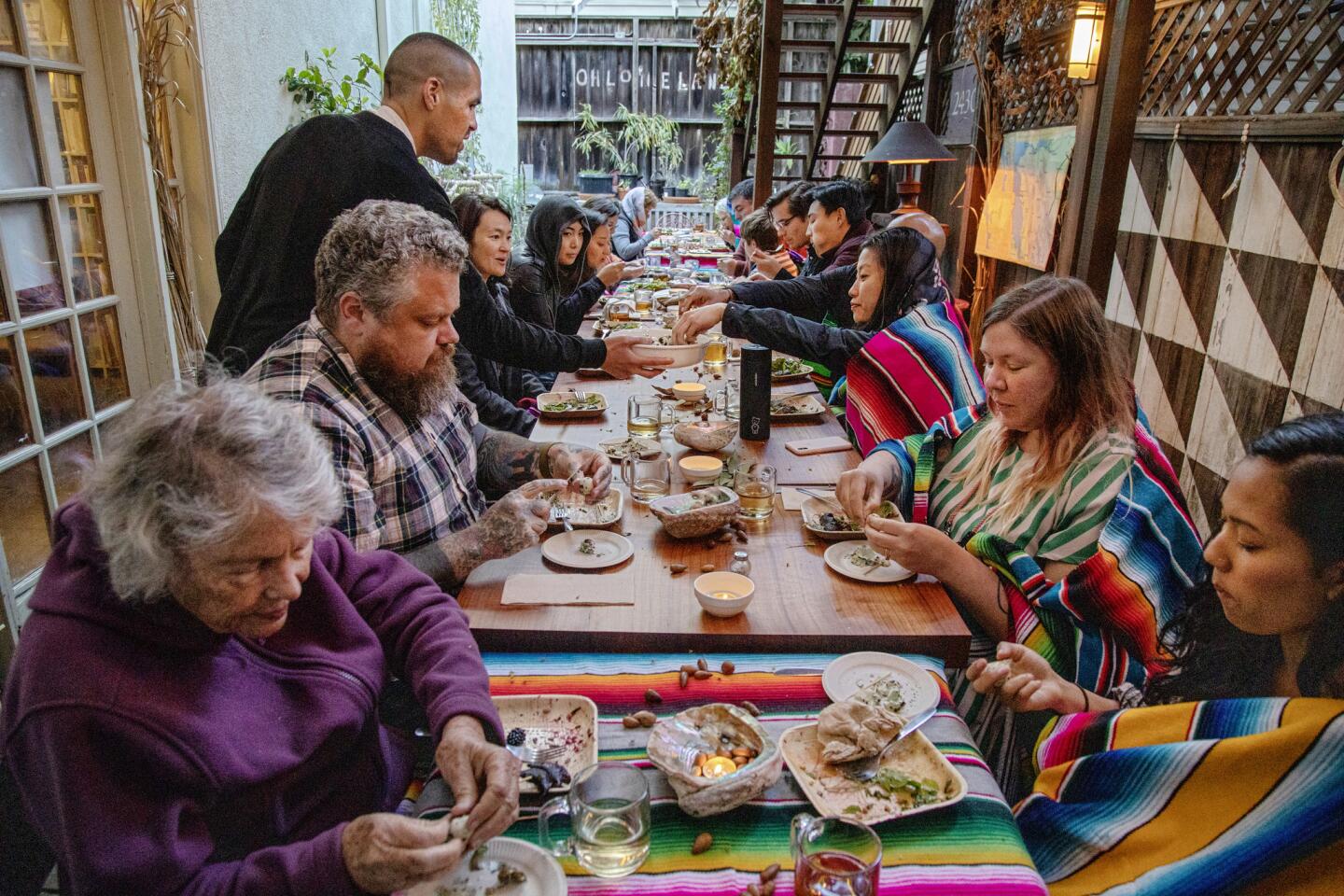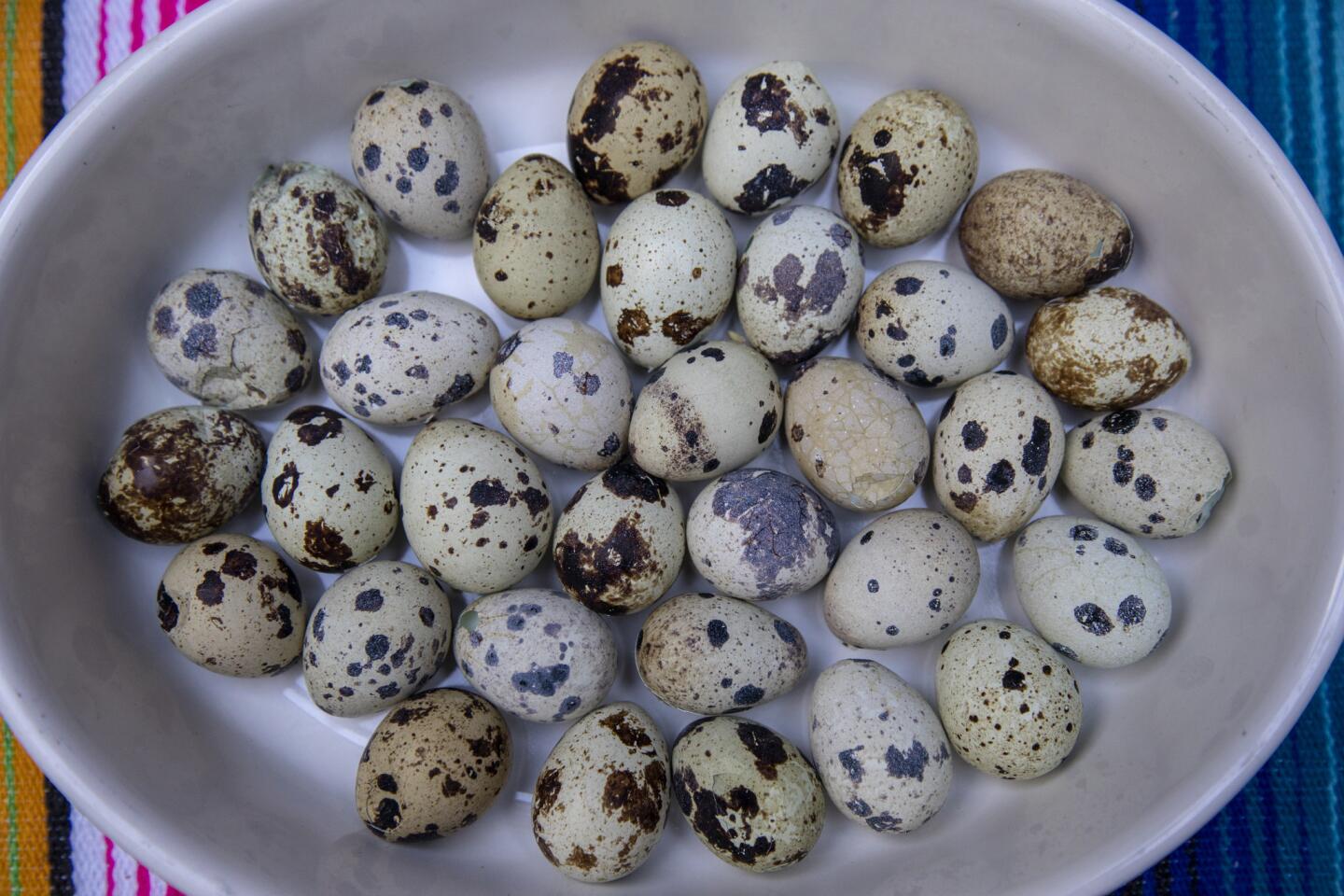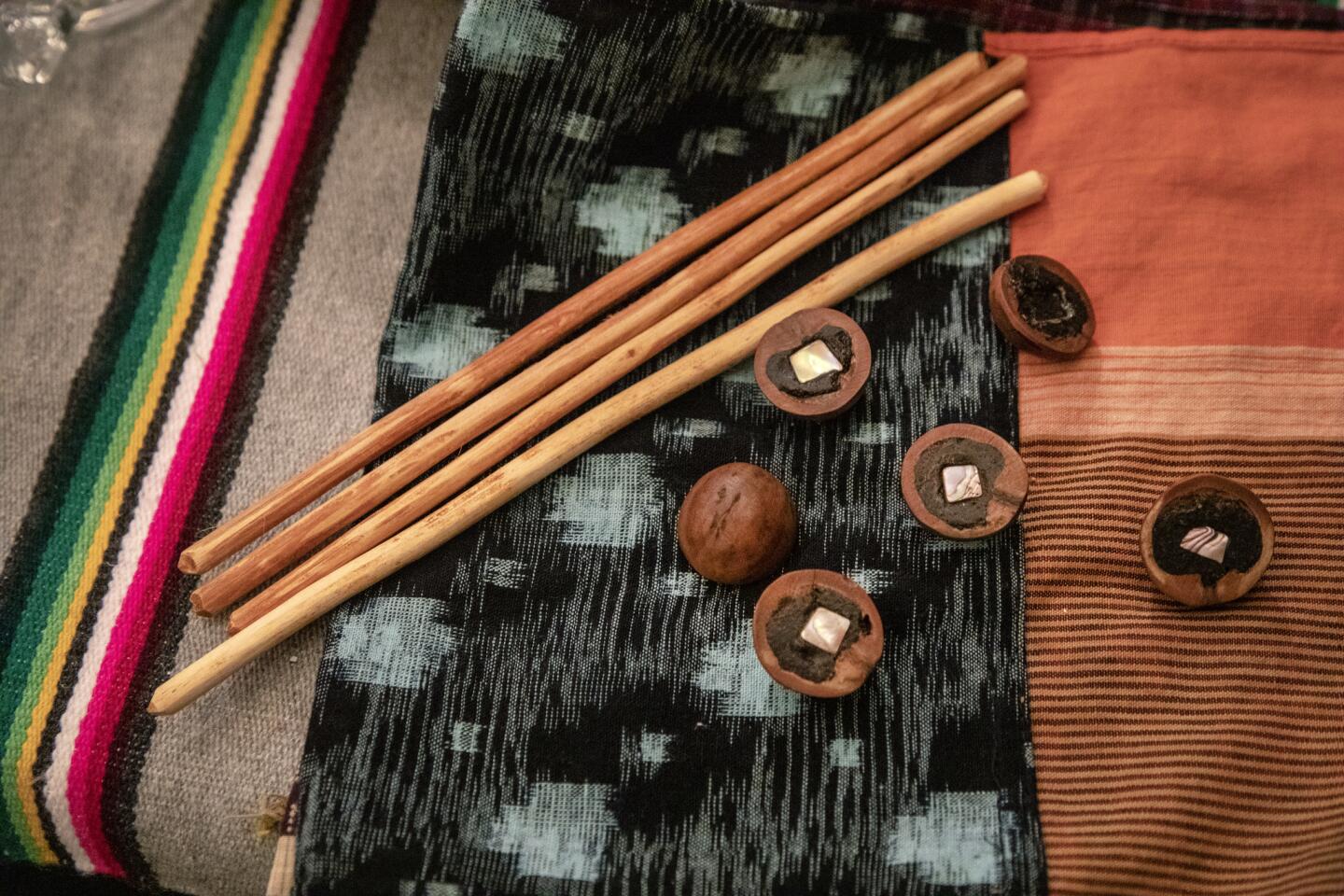In Berkeley, Cafe Ohlone brings back the Bay Area’s first foods

- Share via
Acorns and fat California hazelnuts trail along the center of the table — several tables, actually, a lovely varnished slab of naked redwood and several plastic folding numbers covered in Indian blankets, pushed end-to-end to snake the narrow length of this Berkeley patio. The night is cold and clear. The three dozen of us who ponied up $100 to be here know why we’ve come: to taste food hauled back from extinction.
We’re on this patio to reverse time, to eat as if the European “discovery” of California had never happened; to un-erase the Ohlone, indigenous people who for 20,000 years inhabited a broad sweep of California’s Central Coast from the Golden Gate to Monterey and east through the Salinas Valley. In this urban patio, its own minuscule valley, carved out from adjacent two-story buildings, we’re here to taste a cuisine some of us have only imagined as kids, staring at some overhead-projected rendering in fourth-grade California history of seemingly happy jerkined Indians gathering acorns in a grove.
Almost everything on the menu was picked or pried from the tidal marshes, flats and hills along the eastern flank of San Francisco Bay.
The patio is Café Ohlone, a semi-permanent restaurant serving weekly lunches and teas and twice-a-month dinners. It’s the creation of two men from different Ohlone tribes, raised in different parts of California. Vincent Medina, 32, is Chochenyo Ohlone; he grew up in San Leandro and San Lorenzo, adjacent bedroom suburbs south of Oakland that occupy his ancestral lands. Louis Trevino, 27, is from San Pedro, but his heritage is Rumsen Ohlone, the people who inhabited Monterey and the Carmel Valley. Medina and Trevino are gay and coupled. LGBTQ people who come out publicly often find themselves alienated from families and rooted connections, yet Medina and Trevino, in reviving both food and language, are preserving the deepest parts of Ohlone culture. Medina says ostracizing people for whom they loved was a Spanish and American import. “It’s never been an issue with our people.”
What Medina and Trevino are doing doesn’t fit a restaurant template — despite website copy that describes it as “modern Ohlone cuisine,” what Medina and Trevino are really aiming for isn’t innovative dining. It’s to drag into the open the unearthed foodways of a culture once thought to be dead.

The night’s first bite is already on the table. I overlooked it at first; actually I thought it was a bit of décor, like the hazelnuts and acorns. It’s a tiny amuse-bouche, rustic and adorable: a small watercress leaf picked from Medina and Trevino’s backyard in San Lorenzo, bearing a khaki-colored ball with dark flecks and a dried strawberry, which is cinnamon-brown and lumpy, bristling with pale achenes. The ball turns out to be a truffle — like a chocolate one, only this was made from the nuts of the California bay laurel (Umbellularia californica), gathered in Sunol, an unincorporated part of Alameda County, and dried for weeks, roasted dark, pulverized in a mortar, and seasoned with salt from San Francisco Bay. Sunol is “where our family’s rancheria was, Medina says. The salt comes “from the same ponds,” he says, “that our ancestors have always gathered their salt from.” The truffle’s texture is both waxy and powdery, while the taste, beneath the tannins, has an umbrous sweetness, delicious and strange.
Medina calls himself a California Indian (he rejects “Native American,” considering it a term of occupation, forged by progressive whites out of misplaced sensitivities). He and Trevino launched Café Ohlone/Mak-’amham (it means “our food” in the language of the Chochenyo Ohlone) in the fall after popping up at gallery events in Oakland. Since then, Medina and Trevino have made it their mission to educate anyone who shows up about Ohlone food and culture, as well as a simple message of survival: California Indians are still here. These foods never really went away.
Some of the Ohlone retreated to rancherias for a couple of generations and cooked the Californio Mexican foods that Medina and Trevino trace to the Ohlone’s enslavement in the missions (Trevino grew up around his family’s Mexican restaurant in Chino Hills, northeast of Anaheim). The remaining Ohlone — survivors of the genocide of the 1800s and the cultural extinction program of the 1900s — laid low as best they could. So low, in fact, that in 1925 an influential California anthropologist declared the Ohlone dead. UC Berkeley’s Alfred Kroeber wrote that the Costanoans (his name for the Ohlone) were extinct “so far as all practical purposes are concerned.” But they weren’t. Kroeber, in the 1950s, had to walk his death pronouncement back. The Ohlone, however, are not recognized as an existing tribe by the federal government.
Medina addresses the crowd shoehorned around the table. He stands at the very end of the patio, under a suspended screen that projects a PowerPoint presentation. His voice quavers a little when he speaks; he’s nervous. He has on a black peacoat with a flipped collar and a gray knit scarf that hangs long from his neck like a Catholic priest’s stole.
“Having this dinner centered on the community and spreading these foods back to the public and to the world around us means a great deal,” Medina says after introducing some special guests (his grandmother, an aunt, a cousin), “We know these foods haven’t been in our lives for at least two generations, and for the first time we’re seeing them being celebrated, enjoyed and eaten.”
We eat hazelnut biscuits, round like hush puppies. It’s a modern dish, a kind of soft, lightly sweetened cookie ball made from hazelnut flour, coconut sugar, vanilla, walnut oil and bay salt. “We gather these hazelnuts when we can,” Medina says, “but we have to be very honest about how hazelnut groves are threatened here in the East Bay, so we often can’t gather as much as we want.”

Medina and Trevino aren’t unyielding about sticking to a pre-contact diet (Trevino makes chocolate brownies, for instance, albeit with acorn flour). “We like to think about if there was just never any invasion,” Medina tells me. “If we just got to absorb whatever we wanted, on our own.” Their fantasy of Ohlone California in the 21st century includes morning cups of coffee, pale with hazelnut milk they make themselves, flavored with native bay leaves.
The next course is venison albondigas, the meatballs made from a deer that somebody they know shot. They’re sunk in a murky broth of wild mushrooms, flavored with California bay and dried porcini — it tastes rich but flat, and the meatballs are bland. Next to it is a salad of pure exuberance: watercress, wild sorrel and pickleweed foraged near the bay, with caramelized native gooseberries and fresh currants, walnuts, piñon nuts and hazelnuts crushed in a mortar.

Medina plays emcee, taking us through a PowerPoint presentation on the oppression of the Ohlone as we eat, but Trevino hangs back. Trevino looks like a PhD candidate perennially absorbed in his thesis, and studiously groomed: large glasses cantilever off his thin face, his hair cut in a high fade, lacquered stiff on top. For seven years, he worked as a curator at Mission Dolores in San Francisco, where he led three tours a day, talking about the history of European colonization from an Ohlone perspective. But the stress of describing the enslavement of his family took a toll. “In our culture,” Medina says, “it’s still very much a place of death.”
He quit Mission Dolores and took a job as a produce guy at Berkeley Bowl, tending vast aisles of fruits and vegetables. Hardly anything was native to California, but enough was. In the wild strawberries that showed up once a year, the foraged chanterelles and bulk bins of California piñons and hazelnuts, Medina felt a quiver of the recognition he knew from the East Bay hills, on harvesting trips for wild yerba buena (Satureja douglasii), the indigenous mintlike herb the Ohlone steeped to make tea. But it was Ohlone acorn bread that symbolized, for Medina and Trevino, Mak-’amham’s fusion of language, culture and food.

“One of the things that I was given as a child,” Trevino told me , “was this notebook that contained these vocabulary lessons from Central California.” Some of the lessons were in Rumsen, the language of Trevino’s people. They included the 1902 reminiscences of an Ohlone woman from Monterey about acorn bread. “I would ask my grandmother, ‘What is acorn bread?’” Trevino says. “‘What does it taste like, what is that?’”
As a young man, Trevino discovered an interview with an Ohlone woman, Laura Ramirez, from 1929. She described the process of making acorn bread, pullum in Rumsen.
“And at the end of it,” Trevino explains, “she says, ‘It’s so delicious, I wish we could try some right now.’ ” Another Ohlone, Isabel Meadows, who was living in Washington, D.C., at the time and interviewed at the Smithsonian, also described the recipe: how to process acorn flour and make it into a soup, gradually thickening it and letting it cool and set to become bread. Last year, Trevino says, he and Medina decided to follow Meadows’ instructions with valley-oak acorn flour they had at home (they buy it from a Korean woman in Martinez, who runs a hot dog shop and makes acorn-flour biscotti on the side). The acorn bread was delicious, just the way the women described it.

“You understand exactly why they really wanted to have some,” Trevino says, “because these were people describing things from their childhoods, who hadn’t had them in a long time. So now we get to make it, and it’s like feeding that old desire to taste it.” Like a seed buried in the ground for decades, quiescent until the right conditions returned, acorn bread is sending up a fragile embryonic shoot here on the patio. The pullum gets passed down the table, golf ball–size pieces piled up in a double-handled serving dish. The one I take has the color of Grape Nuts and a skin that looks nearly as craggy. But it’s bouncy — gelatinous — and feels clammy and cold against my lips this chill night, but the taste suggests warmth: an almost toasted-coconut flavor with a flicker of cinnamon, though it contains neither. “This is exactly from the documentation of the 1930s,” Medina says. It feels nourishing, as if it could indeed sustain life.
His PowerPoint stalled from yet another glitch, Medina goes on talking below the bright blue default screen — about reviving indigenous culture in what he calls a holistic way, as a declaration of indigenous presence in every sphere, not just food. The crowd of us around the jerry-rigged table is pure Berkeley: middle-aged environmentalists, earnest-looking couples in their 30s who probably work at nonprofits, university graduate students with cash to spend. Except for Medina’s relatives, almost all of us are white.
“We want our language back, which now it is,” Medina is saying, and most of us are rapt, sipping paper cups of warm elderberry and rosehip tea, sweet from wildflower honey. “We want land sovereignty and stewardship back,” he says. “We want our food back. We want everything back.” He fumbles with his laptop. The slideshow starts up again.

More to Read
Eat your way across L.A.
Get our weekly Tasting Notes newsletter for reviews, news and more.
You may occasionally receive promotional content from the Los Angeles Times.




























